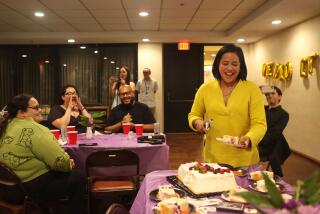Dolores Ibarruri; Spanish Civil War’s La Pasionaria
- Share via
MADRID — Dolores Gomez Ibarruri, famous as La Pasionaria, the legendary heroine of Spain’s Civil War, died in a hospital from double pneumonia Sunday night at 93.
La Pasionaria (Passion Flower), a lifelong Communist who remained honorary president of the Spanish Communist Party, won fame for galvanizing resistance during the 1936-39 Spanish Civil War.
La Pasionaria’s cry of “No pasaran” (They shall not pass) rallied thousands to the Republican cause, and she became a symbol of resistance to the dictatorship of Gen. Francisco Franco.
“Dolores, this flower of the 20th Century, lives on in the daily activity of thousands of men and women in Spain and in the world who aspire to a society where life and human beings are regarded as the center of all social and political initiative,” the party said in a statement after her death.
Dr. Juan Beltran, head of the Ramon y Cajal Hospital in Madrid where she died, said several members of Ibarruri’s family and Communist Party leaders were by her side when she died.
Ibarruri fell ill with pneumonia in September but had begun recovering and returned home three weeks ago. She was readmitted to the hospital last week after suffering a relapse.
A local news agency report quoted party sources as saying Ibarruri’s body would be embalmed.
Many literary scholars believe that she was the model for Pilar, the energetic heroine of Ernest Hemingway’s novel of the war, “For Whom the Bell Tolls.”
Although her forces were defeated by Franco, she outlived the Spanish dictator and ended a 38-year exile in the Soviet Union by returning in triumph in 1977.
In the first democratic elections since Franco set off the bloody three-year civil war, she won back the Parliament seat she had held four decades earlier. She later gave it up because of her age.
On Dec. 9, 1985, figures from the international Communist movement--and from Spain’s Socialist government--feted La Pasionaria on her 90th birthday.
Born Dec. 9, 1895, into a Roman Catholic mining family in Gallarta in the Basque province of Vizcaya, Dolores Ibarruri was the eighth of 11 children.
In her autobiography “The Way,” Ibarruri wrote that she had “an unhappy childhood and an adolescence without hope” and said the harsh conditions in which her family lived turned her into a revolutionary.
“I knew the terrible pain of days without bread and winters without fire.”
Her family was too poor to pay for schooling so she abandoned her ambition of becoming a teacher. She married Julian Ruiz, a socialist activist five years her senior. Ruiz, who claimed he guided La Pasionaria politically, once recalled her as being as independent as a mountain goat.
Separated from his wife since the 1930s, Ruiz died a few weeks after her return to Spain from Moscow.
Ibarruri wrote that she found married life “odious and unbearable.” Four of her six children died in infancy, including triplets born in 1923.
Ruiz was often jailed for labor agitation and unable to feed their two remaining children--a son, Ruben, who died in the battle of Stalingrad, and a daughter, Amaya, the sole surviving child.
Dolores Ibarruri turned to politics after Ruiz introduced her to socialism and Marxism. She read about the Russian Revolution. “Two names,” she wrote later, “struck me in my heart and in my head--Russia and Lenin. I no longer felt sad; I no longer felt alone.”
She began a career as a labor organizer and strike leader and wrote articles she signed as La Pasionaria, a name she chose in 1916 because her first article appeared during Holy Week, known in Spanish as the week of the Passion.
In 1934, she led a rebellion by 40,000 miners in the northern province of Asturias.
Soviet communism became La Pasionaria’s religion. She visited Moscow in 1933 and 1935, when she was elected deputy to the Parliament from the town of Oviedo.
When the civil war broke out in July, 1936, she sent her surviving children to the Soviet Union, remaining in Madrid to lead rallies, visit Republican forces and make her ringing radio broadcasts.
Her ability to recruit fighters was so strong that her enemies often claimed that she was being guided directly by Moscow.
With Franco’s victory imminent, La Pasionaria fled to the Soviet Union in 1939. She was named secretary-general of the Spanish Communist Party in exile in 1942. She became president in 1954.
She saw the once powerful Spanish Communist Party, which she helped found in 1920, split into factions and become a minor political force under the constitutional monarchy of King Juan Carlos I.
She witnessed the party’s move away from Moscow without saying a word. But she always remained an unshakeable supporter of the Soviets, who gave her the Order of Lenin, one of the Soviet Union’s most prestigious honors.
More to Read
Sign up for Essential California
The most important California stories and recommendations in your inbox every morning.
You may occasionally receive promotional content from the Los Angeles Times.













